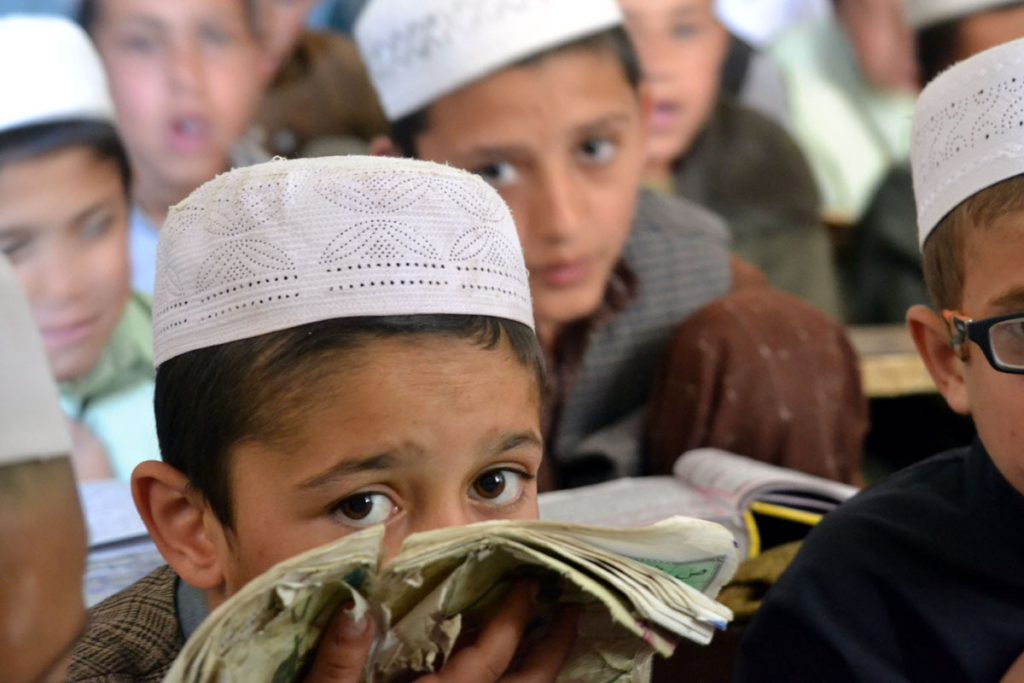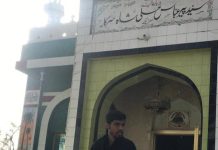
Peshawar: There is something of an adult about Shad Wali as he surveys the trash heap like a canny prospector, teasing scraps out of the garbage, keeping them or throwing them aside if they seem worthless.
One can almost imagine the nine years old mind working tirelessly – a perpetual calculator for potential value of worthless things, trash people throw out in the streets of Saddar in Peshawar.
Wali finally finds something of value in the heap. It is a torn book that he hopes he can sell at the junkyard in the city. He thumbs through the soggy pages of the book reflectively, stopping to look at pictures before tossing the book into his grimy gunny sack.
“I want to go to school but i come from a poor family that cannot afford to send us to school,” says Wali, accompanied by his younger brother who is also busy foraging in the garbage heap. “My mother says that my father’s income is not enough to meet our needs.”
Wali and his brother collect scraps all day, making Rs 300 ($3) at the city junkyards where they sell them. They are among the nearly 181,000 children aged between 5 to 16 years that are out of school in the provincial capital, according to the education campaign Alif Ailaan.
Alif Ailaan’s annual report for the year 2015 – the year when Pakistan should have achieved universal education for all children, in keeping with its commitments under the Millennium Development Goals (MDGs) – says thousands of children are still out of school in Peshawar despite enrollment drives that are launched every year with great fanfare.
Alif Ailaan, a campaign that seeks to put education at the heart of public discourse in Pakistan, says 16 percent of boys and 32 percent girls are out of school due to poverty and lack of interest on part of parents and the government.
“Peshawar is ranked 68 out of the 146 districts of Pakistan according to Alif Ailaan’s Pakistan District Education Ranking 2014,” Umer Orakzai, regional coordinator for Alif Ailaan, told News Lens. “It is ranked 10 out of the 25 districts of Khyber Pakhtunkhwa.”
Poverty plays a vital role in keeping children out of school, according to Alif Ailaan’s annual report, with 41 percent of children belonging to poor families out of school whereas only 11 percent of children from rich households are out of school.
The report says that the total allocated budget for education in Peshawar District education was Rs 3.421 billion of which a major portion – a whopping Rs 3.393 billion – was spent on salaries. The remaining Rs 28 million was spent on other expenses and development work.
The net enrollment rate at the primary level is 61 percent which drops to 25 percent at the middle, and only 12 percent at the high school level, says the report.
The net enrollment rate for boys at the primary school level is 66 percent. For girls this percentage is slightly higher – at 57 percent. According to the report, almost 54 percent of students are enrolled into government schools, 44 percent students into private schools and only 2 percent go to madrasas.
The report says that of all the girls who enter school, only 48 percent remain beyond class 5. Of all the boys who enter school, 65 percent continue education beyond class 5.
“Almost 77 percent of the total government schools in the district cater to the primary level needs,” said Orakzai, the regional coordinator for Alif Ailaan. “There are 1,353 government schools out of which 1,042 are primary level schools.”
Of the 1,353 government schools, said Orakzai, 42 percent schools were girl schools, compared to 58 percent for boys. “This makes a total of 780 schools boys whereas 573 schools for girls.”
About the quality of education in Peshawar, the Alif Ailaan report says 62 percent of class 5 students cannot read a simple story in Urdu (text meant for students of class 2), 56 percent of class 5 students cannot read a sentence in English (text meant for students of class 2) and 61 percent of class 5 students cannot do class 3 level of two digit division.
Of school infrastructure in the provincial capital, the report says that water is not available in 20 percent of the schools, 9 percent schools do not have toilets, 39 percent schools do not have electricity, 5 percent schools do not have a boundary wall. On average there are just five classrooms in a single school at the primary level.
When it comes to teachers availability in schools, 7747 teachers were appointed in the 1,353 government schools in 2014. 12 percent of the primary schools have only one teacher. At the primary level, on the average, around 48 students are taught by a single teacher.
Malik Khalid, Provincial President All Primary Teachers Association (APTA), told News Lens that the dropout ratio in the government schools was on the rise due to lack of interest on part of the government and parents.
“A majority of parents of out of schools children are poor and work as labour,” said Khalid. “Their children are also a source of income for poor families who don’t understand that they are destroying their children’s future.”
Khalid suggested that the government, the education department and teachers should come up with a solid policy for out of school children and convincing parents about the value of education. He appreciated the scholarship initiative of the provincial government for girl students in the rural areas.
“The government is responsible for out of school children,” said Khalid. “Despite huge spending in the education sector, a majority of schools lack of basic facilities.”
Talking to News Lens, Peshawar District Education Officer Sharif Gul admitted that schools lacked facilities. He said the government was taking steps to address this. He said that during the education enrollment campaign launched on April 8 in Peshawar, around 20,000 children were enrolled in different schools.
“Hundreds of teachers have been appointed in Peshawar and next we will be focusing on providing the basic missing facilities,” said Gul.
But time is running out for children like the the eight years old Javed, who works at a tea restaurant in the Khyber Super Market, Peshawar, to support his family.
“I get Rs 200 ($2) for a day’s work,” says Javed. “I come early in the morning and work till 11 pm daily. I don’t like being dirty. I want to go to school all neat and tidy. I want to have a bag full of books. I want to play games in the evening like children from rich families. But I think such leisure is not our fate because mother says we are poor.”




it is a very informative report and i like the way things have been shown to every body for a thought and specially for those at the helm of affairs.thanks to ALIFF ALIAN and Shahid Kazmi